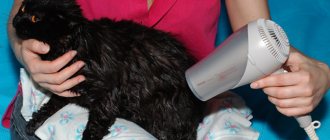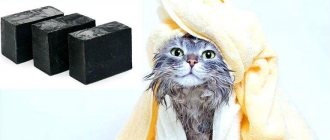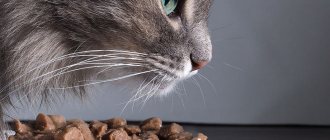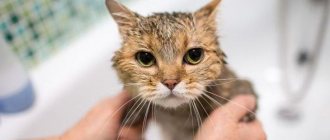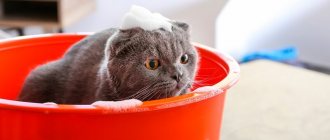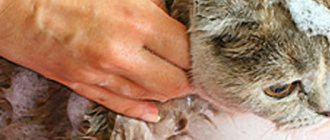Pet owners are wondering whether and how to properly bathe a pregnant cat at home. Veterinarians do not give a definite answer, but claim that if there are no health problems and if the pet is in good health, this procedure is allowed. But be sure to follow specific rules when washing the expectant mother.
Why is it better not to bathe a pregnant cat?
Cats are naturally clean. You may not believe it, but there are thousands of cats that have never been bathed in their lives and this has not led to illness or deterioration in the quality of their coat. While the cat is healthy, it does not need to be bathed unless you are preparing for a show or the pet has not gotten dirty.
Bathing is very stressful for almost all cats. The exception is cat breeds that love water, but it is better not to bathe them during pregnancy.
What happens to a cat while bathing:
- Sharp temperature contrast.
- Damage to the protective lipid layer of the skin, which can lead to itching.
- Complete soaking leading to temporary hypothermia
- In 99% - fear, stress and severe discomfort.
The combination of these factors negatively affects the condition of the expectant mother. If the cat splashes the water too hard, bathing can lead to miscarriage.
In what situations are the risks associated with swimming justified?
As they say, you need to choose the lesser evil. A pregnant cat will have to be bathed, despite the risks, if:
- Toxic substances, such as contact poison, have come into contact with the fur.
- The fur is so dirty that it attracts flying insects.
- The cat got dirty with combustion products - gasoline, diesel fuel, motor oil.
- Glue or other liquid has come into contact with the cat's fur, which reacts with the skin at the molecular level.
- Alkali or acid has come into contact with the cat - thoroughly blot it with paper towels, grease it with oil, and bathe it.
This is interesting: Is it possible to terminate a cat's pregnancy?
Safety of disposal
It is imperative to treat an infected cat when she is pregnant. Constant bites and discomfort experienced by the animal can lead to nervous exhaustion.
In addition, being carriers of dangerous infections, parasites can infect the animal with tularemia or hemobartonellosis.
Immediately after birth, fleas infest the kittens' fur. They can cause much more harm to newborn babies than to an adult animal, for example, infecting them with worms or leading to anemia.
For a fragile kitten or a cat weakened by childbirth, the consequences of fleas can be fatal.
Fleas often contribute to:
- animal exhaustion;
- infection with worms;
- baldness;
- the occurrence of allergic dermatitis;
- infection of pets;
- constant nervousness of animals.
When carrying out disinfestation, special attention should be paid to the safety of use. Otherwise, you can harm not only the pregnant pet, but also her offspring.
Alternative to swimming
When we are not talking about contamination that does not entail poisoning, burns or other threats to life and health, the fur of a pregnant cat should be cleaned using alternative methods.
Wool cleaning cloths
Many people don’t even know that there are special wet wipes for cleaning cat (and dog) hair. The wipes are impregnated with a special, gentle solution that:
- Deodorizes wool (unscented wipes are available).
- Hypoallergenic.
- Contains beneficial essential oils - eliminates skin irritation.
- Does not contain alcohol.
Instructions for using wet wipes for cats:
- Choose a time when your cat is relaxed. The optimal time is before bedtime or after play, when the cat is no longer active, but not too tired.
- Pet the cat. To make your pet feel comfortable during the cleaning process, continue to pet him while using the wipes. If the cat is very nervous, ask members seven for help and take breaks.
- Rub the wool smoothly. You should not rub the fur, even if it is very dirty. If there is dried dirt on the fur, place a napkin on top for 10-30 seconds and distract the cat by stroking it. The cat wipes are barely damp, but the special solution penetrates the dried dirt and softens it.
- Moisturize your skin. After removing pockets of contamination, wipe the cat with a clean cloth along the entire length of the body. This is necessary so that the balm and essential oil are evenly distributed over the coat and skin.
Note! Cat wipes have a neutral pH, so they can be used to clean the fur on the face and the skin on the inside of the ears.
Lastly, if the cat has not started to get nervous, wipe the pads of the paws and the spaces between the toes. It is advisable to make this procedure permanent if the cat walks outside.
Dry shampoo
Dry shampoo is a powder similar to powder or starch. Choose the product carefully and read the instructions:
- Look for contraindications - some dry shampoos cannot be used on kittens and pregnant cats.
- Don't buy dry shampoo with anti-parasitic properties.
- Look for a shampoo that contains a moisturizer - it is extremely important to ensure that you do not harm your pet's skin.
Advice: if you have never used dry shampoos, it is better to consult your veterinarian about the choice of product.
Instructions for using dry shampoo:
- Choose a good time to brush the fur - the cat should not be excited.
- Apply shampoo to a small area of the coat and rub it into the coat with a dry cloth or hand.
- Distribute the shampoo over all contaminated areas of the coat and massage them.
- Remove shampoo from the coat using a fine-toothed brush.
- Carefully inspect the fur and skin for powder residue - the cat should not lick it off.
Cleaning and shortening the coat
The safest way to keep a pregnant cat's fur clean is through prevention:
- Brush your cat regularly. It is better to use a special glove.
- If there are spikelets or sticky seeds stuck in the fur, carefully cut off the tangled hairs.
- It is better to shorten the fur of a long-haired cat in advance - the anus area, the riding breeches area, the abdominal area and other areas that will be difficult for a pregnant cat to reach for licking.
Why do you need bathing?
Bathing is not just washing the paws after a walk outside, or when they become very dirty.
The process involves completely immersing the cat in water, and this is done in the following cases:
- for prevention;
- if there are fleas;
- strong dirt has formed on the fur.
Long-haired pets should be bathed more often, especially before exhibition days. Owners often wonder if it is possible to bathe a pregnant cat?
There is no clear answer to this question. In general, pregnancy has no contraindications to swimming.
But, you need to take into account a number of nuances:
- It is recommended to wash pregnant cats only if there is a threat of some harmful or toxic substances entering its stomach;
- Even the smallest trauma can affect children, and their psyche in particular;
- To ensure that shampoo residues that enter the animal’s digestive system do not harm future children, you can often replace regular cat shampoo with homemade dry scrubs. They are based on oatmeal, starch and baby powder. Chemistry can ruin subsequent lactation after childbirth.
When deciding whether it is possible to bathe a pregnant cat in water without violence, keep in mind that the answer will be this: it is still better to turn your attention to other methods of care. For example, your pet needs to be taken to the veterinarian periodically.
He must examine her for the presence of worms, which can harm babies. You also need to make sure there are no fleas. If they are, then ask about a safe method of getting rid of them.
A proper diet and the availability of fresh water are of great importance for health. The cat's litter box must be clean at all times. However, if for essential reasons bathing is irreversible, everything possible should be done to ensure that this process takes place correctly and painlessly.
How to choose shampoo for a cat
Due to the different acid-base balance between humans and animals, it is not necessary to use soap products that people use. This can injure their skin and damage their fur.
The following cat shampoos are used:
- Liquid. They contain a high flushing efficiency. There are different purposes, they wash away dirt well, and the wool becomes pleasant to the touch. If possible, it is worth using an imported, more expensive option. But domestic shampoos are not much inferior in quality. All of them cannot be used more than 3 times a year, because this disrupts the sebum balance;
- Dry ones are simply a salvation when your pet has a panicky fear of water. The difficulty in using them is that some animals do not allow the detergent to be combed out of their fur. This procedure is especially difficult for long-haired cats. Remember that a high-quality shampoo contains substances that have an effect similar to a balm that makes combing easier. It is also good because it is suitable for frequent use, you can safely wash your cat’s hair with it, and it is suitable for bathing before shows;
- Sprays. They have the same functionality as dry shampoos, but are more convenient to use. Additionally, they have a perfume scent and antistatic protection.
How to prepare for the washing procedure
When preparing for a swim, consider the following points:
- Using dry shampoo, which has a consistency similar to powder, will not cause any problems other than combing;
- The cat may be frightened by the sound that accompanies the use of the spray. If this is so, then it is better not to torture her;
- Regular washing is always stressful for a pet, so you need to carefully prepare for it;
- The cat is not fed 4 hours before the bathing process;
- There is an increased risk of injury when swimming in water.
Before taking a bath, you should check the temperature. Meowing pets quickly become hypothermic and, accordingly, catch a cold. The room temperature must be above +22°, and the water must be heated. You can check how comfortable washing will be by sticking your elbow into the basin. It is necessary to achieve the effect that when testing with your elbow, the water is not felt (which is usually observed at its temperature of 36.6°). To protect your pet from colds, owners should avoid drafts in the house.
The cat is a very prudent and sensitive animal. Therefore, she can guess in advance what awaits her ahead. In order to somehow deceive, you simply shouldn’t open the water or a tube of shampoo when you have a pet. She is more afraid not of water, but of the noise it makes when it flows from a tap or splashes in a container.
You need to prepare one basin for bathing, the second for rinsing. But it is best to bathe in the bathtub, and then the cat will not be able to cling to the sides with its claws. Her desire to break free will interfere with thorough washing.
And one more thing: water should be taken according to the level of the pet’s abdomen.
After entering the bathroom, you should not immediately throw the animal into a container of water. It is better to stroke and calm him down, and then carefully put him down. Then wet the wool, and hold it firmly in your hands. Bathing should take place without sudden movements and screams, which can frighten even more. Cat shampoo foams easily and takes a very long time to rinse off. Therefore, it must be applied in small quantities to avoid unnecessary inconvenience.
And the cat should not be poisoned by the remnants of the shampoo, since after bathing it tries to lick its fur in the best way possible. You also need to pay close attention to ensure that no water gets into your ears. This unpleasant moment can lead to a lot of health complications associated with inflammatory processes and diseases of the hearing aid.
The final chord of the whole epic will be drying. The pet is wrapped in a towel and the wet fur is blotted. If he is not afraid of the sound of a hair dryer, then you can speed up the drying process. Never allow your animal to shiver from the cold.
In principle, this is all that is required to redeem your meowing happiness three times a year. Remember that the cat’s psychological state may be disrupted after bathing. But, after a couple of hours, there will be no trace of stress left, and she will trust you again.
Description of breed standards
If a cat's body is not covered with hair, this does not mean that he is a representative of the Canadian Sphynx. Even the smallest deviation from official standards turns the animal into an ordinary hairless cat. Features of the appearance of the Canadian Sphynxes are as follows:
- The size of the pet is small. As a rule, they weigh no more than 6 kg. Females are somewhat smaller than males. Their weight is about 4 kg.
- Animals are distinguished by a muscular and strong physique, but at the same time they have soft and smooth body contours. They captivate with their grace and elegance. Sphynxes have a round belly that resembles a ball.
- The chest is quite wide, which is why the pet’s paws are always widely spaced. The limbs are medium in size, thin and strong with long fingers, on which sparse fluff may remain. The hind legs are longer than the front legs, which makes the gait special.
- The head is wedge-shaped, medium in size, with prominent cheekbones.
- The bridge of the nose is wide, the nose is small, slightly covered with short hair.
- The ears are set far apart and may droop. They are large with a wide base and rounded ends without brushes.
- The eyes are large, deep and very expressive, shaped like a lemon. Color may vary. Usually it harmonizes with the color of the animal, but most often the bright green shade predominates.
- The tail is long, sometimes with a tassel at the end. Animals most often roll it up and press it to their body.
- Mustaches are practically absent, but their presence is allowed.
- The nose, the area behind the ears and the tip of the tail are the only places that may be covered with short hair or fluff. Canadians' skin is quite soft and velvety.
- The color can be absolutely anything: monochromatic or in various combinations. Black, purple, silver, white and other shades are allowed. Due to their susceptibility to pigmentation, tri-colored individuals are often found.
One of the peculiar features of Sphynx cats is that they have interesting folds that do not straighten out even if the cat is pulled out to its full length. The presence of folds on the forehead, neck and limbs is considered mandatory.
Why is bathing undesirable if the cat is pregnant?
Pregnancy has no contraindications as far as hygiene procedures are concerned. But it is considered undesirable to wash an animal’s fur using shampoo. The product contains many components of chemical origin, including toxic ones. The owners are worried about the future offspring, because the cat can harm the kittens when licking its own fur.
Veterinarians do not give a clear answer to the question about washing pets during this period. It is recommended to avoid water treatments unless absolutely necessary.
But if the cat is accustomed to bathing and the smell of shampoos, then you can wash the animal. If contact with water causes negative emotions in her, then rinsing the wool should be done as carefully as possible. There is no need to make sudden movements, hold the pet by the withers or place it in a bathtub in which the water level is higher than the cat itself.
When swimming, you should follow a number of rules that can simplify the procedure:
- The water temperature should be comfortable for the animal. It is necessary to ensure that the water is not too hot or cold. Otherwise, the pet will catch a cold, and during pregnancy this is very dangerous.
- If the cat does not need to wash its entire body, then you should not soap it entirely. The cat's paws are dirty after a walk - only the fur and toe pads should be washed.
- Shampoos should not be used unless absolutely necessary. If your pet has fleas, then it is more rational to purchase special capsules or a collar that will help remove the parasites. There are also dry shampoos and sprays that do not require contact with water.
It is worth washing a pet only in cases where the use of other hygiene products does not make sense. It is important to take into account the physical condition of the animal and its well-being.
Under no circumstances should you bathe a cat that is having a difficult pregnancy, especially if it is several weeks pregnant. It is worth remembering that not all animals tolerate water procedures easily; for some of them it is a lot of stress.
Features of ridding a nursing cat of fleas
Safely removing fleas from a nursing cat is even more difficult than from a pregnant cat. Newly born babies actively crawl all over their mother and can easily lick drops or bite the flea collar.
A cat can be treated in three ways:
- a special insecticidal composition approved for mothers and their babies. Such products are quickly absorbed into the skin, and kittens will not be able to lick the drug from their fur.
- In the traditional way, wait until the kittens are older (about 3-4 weeks) and can go several hours without feeding. During treatment, the mother is isolated from the babies.
- Comb thoroughly with a fine comb if the number of fleas is small.
After birth, not only the adult animal is treated, but also the kittens, since they are likely to become infected from the mother.
It is known that the problem is easier to prevent than to solve, so during the period of gestation, the cat owner should take preventive measures.
The bed and cat house are treated at the same time as the pet, otherwise the cat will re-pick fleas from the remaining eggs.
It would be a good idea to place branches of repellent plants near the sleeping area that will repel parasites. You can prevent the appearance of insects by regularly doing wet cleaning by adding a teaspoon of vinegar to the water.
How to properly care for an animal's fur?
Caring for a pregnant cat is not difficult, but it is worth remembering some nuances:
- Do not wash your cat's fur with cosmetics intended for humans. Such bathing will negatively affect the animal’s well-being. The cat licks its fur and at the same time is able to swallow the remains of the shampoo. The composition of products for animals or for humans is very different, this can affect the condition of the pet’s skin and coat.
- When drawing water into a bathtub or basin, it is worth considering the height of the pet. It is advisable that the fluid level reaches the abdomen. A pregnant cat should be washed carefully, distributing the soap base with massage movements. The shampoo should be rinsed thoroughly, changing the water several times.
- After bathing, the animal is wrapped in a towel. You should not let her go with wet fur, as she may get sick. If your pet is not afraid of a hair dryer, then you should use it. If it is afraid, then you need to hold the animal wrapped in a towel in your arms for at least a few minutes - until the fabric absorbs excess liquid.
During bathing, it is necessary to calm the cat so that it feels more comfortable. It is worth petting it, scratching it behind the ear - this way the animal will understand that the owner will not do anything wrong and you can trust him.
This is interesting: Which food is best for nursing cats?
FAQ
Let's look at the main features of how to wash a cat at home.
How to bathe a kitten?
We'll tell you how to wash a kitten. When the kitten is a few months old, begin to accustom him to the sound of water and try to get him to go into the bath often. Run a thin stream of water from the tap and show it to the kitten while holding it in your arms. Maybe he'll see it as a new game and won't be too afraid. The noise of the water can be frightening, and the kitten will refuse to wash itself. Do not insist or hit your pet. He will be even more scared.
Here is a step-by-step algorithm for how to bathe a kitten for the first time:
- The procedure is best performed on a warm day in summer or spring. Then the baby will not catch a cold.
- Before bathing, check to see if your pet has scratches, wounds or scratches.
- It is better to choose the moment when the kitten is tired - then it will be easier for the owner.
- The bath is too big and can be intimidating. Bathe your baby in a sink or basin.
- Before bathing, play with your kitten to distract it.
- Wash him with a special shampoo for small kittens.
- You can dry it only with a towel, without a hair dryer.
It is better to trim the cat’s claws a few days before the procedure.
Is it possible to bathe a pregnant cat?
If your cat is pregnant, you should not bathe her until she gives birth. The procedure also cannot be performed immediately after childbirth; it is better to wait a few weeks. Bathing is permissible only in the early stages of pregnancy, and provided that the pet is calm about water.
Is it possible to dry fur with a hairdryer?
Blow-drying is acceptable, but it also needs to be done gradually. The main condition is that the pet is not afraid. Don't dry it with a hairdryer right away; first, just turn on the device at low power. When the animal adapts and gets used to it, slowly direct the air in its direction.
How to wash a cat who is afraid of water?
It is not necessary to wash your cat with water. Wiping with wet wipes or dry shampoos are suitable. The products are diluted according to the instructions on the packaging. If the animal has short hair, dry bran baths will be very helpful.
How to wash a cat so that it doesn't scratch?
To prevent your pet from scratching, trim its nails 2-3 days before bathing. The procedure can be performed either in a veterinary clinic or at home. Another option is to put on special claw covers.
Will human shampoo work?
Owners ask: “Is it possible to properly bathe a cat with ordinary human hair shampoo?” You need to buy a special one for cats so that your pet does not develop skin allergies and does not feel worse.
Soap will make the skin dry, the coat will stop shining, and dandruff will appear.
Is it possible to bathe a pregnant pet?
Before performing the bathing procedure, it is worth learning about other methods of care that are most suitable for a cat in this situation. You can visit a veterinarian with your cat, he will examine the animal and be able to clean the fur from fleas and parasites, if any. Thus, the risk of harm to the fetus is minimized. You can get advice from your veterinarian about safe grooming methods. If the cat is already accustomed to water procedures and the aromas of detergents, then bathing is allowed. If there are negative associations and emotions with water, it is necessary to wash the fur as carefully as possible, without sudden movements, and do not forcefully hold it by the withers, causing pain.
When bathing, it is recommended to follow specific tips that will facilitate this process:
- The temperature should be comfortable for the pet. You should carefully ensure that the water is warm, and in no case hot or cold, as temperature changes can cause miscarriage or a cold.
- If there is no severe contamination throughout the body, for example, if only the paws are dirty, it is not recommended to bathe the cat completely; it is enough to wash only the pads and fur on the paws.
- It is not recommended to wash your cat with shampoo unless absolutely necessary. If you have fleas and parasites, the right solution would be to purchase skin capsules or a specialized collar. You can use dry shampoo, which does not require water to work.
Why is it not advisable to swim?
If bathing is very stressful for your pet, then it is better to postpone the procedure and do it only in case of severe contamination.
Cats require special care for their coat during pregnancy. When an animal licks itself, it can swallow the remains of detergents with saliva. Taking water procedures is a strong stress for the pet, which will not bring benefits for her and future offspring. But there are situations when bathing cannot be avoided: accumulated dirt and dust on the coat after walks, or if parasites have appeared.
Veterinarians believe that washing a cat with shampoo is undesirable, because such products contain chemical elements.
You can bathe your pet only when using other hygiene products is pointless, and you should take into account the health status of the pet and its general well-being. It is not recommended to take water procedures for those individuals whose pregnancy proceeds with complications, even in the first weeks, as this is a strong stress.
Recommendations and reviews from veterinarians
A few simple tips:
- If there is no shampoo for cats, baby soap without dyes or fragrances will do.
- Your pet needs to be accustomed to water gradually; the kitten must reach the age of 4 months.
- Tar soap for fleas and lice in cats will not only cleanse the fur of parasites, but also speed up the healing of the skin. It can be used on wounds and scratches. Tar soap does not have an aggressive effect, unlike many products. After using the soap, your pet will itch a lot.
- Veterinarians recommend bathing pets in thick clothing and gloves, and also ask for help if the pet is angry and may resist too actively.
- When you first bathe an outdoor cat, first you just need to wipe the paws with a damp cloth or soak it under water. The second time you also need to wash the anus, and only then, for the third time, bathe the animal completely.
If your pet begins to behave strangely and shit everywhere, do not use physical force. This will only make things worse. To discourage your pet from a bad habit, use peaceful methods, preferably depriving him of the ability to move around the house. Lock the cat in the room, leaving him food, water and a litter box. After three to four days of isolation, the addiction will pass.
Education University: Moscow State Academy of Veterinary Medicine. Year of graduation: 2010. Specialty: Veterinary medicine, Veterinary medicine. Experience I have experience working in a veterinary clinic for more than 7 years. Experience of the Federal State Budgetary Institution "All-Russian State Center for Quality and Standardization of Medicines for Animals and Feed"
Pregnancy and childbirth in cats
Pregnant animals need special care, including hair care. A cat, while licking its body, can swallow the remaining shampoo, which ends up in the digestive system. In addition, bathing is a lot of stress, which is undesirable for a cat that will soon give birth to offspring. But sometimes washing cannot be avoided: if the animal has fleas or the fur is matted with dirt after a walk. In such cases, other hygiene products are used.
Pregnant animals need special care, including hair care. A cat, while licking its body, can swallow the remaining shampoo, which ends up in the digestive system. In addition, bathing is a lot of stress, which is undesirable for a cat that will soon give birth to offspring. But sometimes washing cannot be avoided: if the animal has fleas or the fur is matted with dirt after a walk. In such cases, other hygiene products are used.
Types of cat shampoos you can use to wash your pet
In order to wash a pregnant cat with shampoo at home, choose the type that will not harm your star’s body. Below you can see examples of such products that you can use to wash your animal.
- With liquid shampoos, washing will be easy and simple. If you have a chance to buy an imported product, take it, since the domestic product has proven itself a little worse in this regard. Such shampoos cannot be used more than 3 times a year.
- Dry shampoos. They are used if animals are afraid of water, and you want to wash it. The problem with using such shampoos is that some violent animals simply do not allow the shampoo to be combed out of their fur. This is typical for long-haired cats. Dry shampoo may contain substances that make combing much easier.
- Special shampoos. They are completely identical in their functions to dry shampoos, but are much more convenient to use. They also additionally have a pleasant scent that you can choose any day.
In order to wash a pregnant cat with shampoo at home, choose the type that will not harm your star’s body. Below you can see examples of such products that you can use to wash your animal.
- With liquid shampoos, washing will be easy and simple. If you have a chance to buy an imported product, take it, since the domestic product has proven itself a little worse in this regard. Such shampoos cannot be used more than 3 times a year.
- Dry shampoos. They are used if animals are afraid of water, and you want to wash it. The problem with using such shampoos is that some violent animals simply do not allow the shampoo to be combed out of their fur. This is typical for long-haired cats. Dry shampoo may contain substances that make combing much easier.
- Special shampoos. They are completely identical in their functions to dry shampoos, but are much more convenient to use. They also additionally have a pleasant scent that you can choose any day.
Removal methods
Before removing fleas from a pregnant cat, you should familiarize yourself with the list of methods used and assess the seriousness of the situation as a whole. Disinsection methods may vary depending on the condition of the animal, its well-being, and the degree of infection.
Anti-flea collars
The simplest thing you can do if you notice fleas on a pregnant cat is to put a flea collar on her. However, this method is not effective and can be used more as a preventive measure.
The collar has a repellent effect on insects, so it makes sense to put it on the cat when the first fleas appear.
In addition, it can rub the animal's neck and also cause allergic reactions.
Safe cleaning products
When using water procedures for a pregnant pet, it is recommended to select those products that can have the least negative impact on the body. It is worth choosing these:
- Liquid shampoos. It would be more correct to purchase imported goods, because domestic ones are of lower quality. Such substances should not be used frequently, only when the pet is heavily soiled.
- Dry detergents. They are used to quickly clean the coat of dust and dirt if the cat is afraid of water. The main problem with these products is that active pets may not allow their owners to comb them out of their fur and then lick them off. This is typical for cats with long fur. The advantage is that after using this shampoo, the combing procedure becomes much easier.
- Specialized products for pregnant cats. They are similar in action to dry products, but they are often released in the form of a spray, which makes the washing process easier. The composition is the safest, they can be used every time you bathe.
Is it possible to wash a cat in winter?
It is possible, but without fanaticism. It is better to exclude swimming in cold weather from a cat’s biography.
It is better to wait for warm days, because it is not so easy to completely dry a cat after water treatments. A poorly dried pet can easily catch a cold and feel unwell.
Finally, we invite you to watch a video with a perfectly calm Maine Coon in a bath cap. He's clearly got Zen!
How to recognize pregnancy
During bathing, the shedding process accelerates, as washing the coat with shampoo and water removes dead hairs. True, many short-haired breeds, for example, some Siamese cats, Orientals and Rexes, lose a lot of hair during shedding and even sometimes have bald spots on their sides, so it is better not to bathe some breeds during shedding.
We suggest you read: How to remove a tick from a cat yourself
Bathing for many meowing pets is an unpleasant, stressful procedure, and if the animal is sick, then bathing it, of course, is not advisable. Drafts can also seriously damage an organism that is still fragile after illness, and during vaccination or quarantine, washing cats by veterinarians is generally strictly prohibited.
The gestation period for almost all cat breeds is about 9 weeks. However, this period may be longer or shorter by approximately 7 days. And that's quite normal. During the first few weeks of pregnancy, your cat begins to eat less. Sometimes this condition is accompanied by short-term vomiting and apathy of the animal. After about a month, the cat's nipples turn pink. After a month and a half, embryos are already palpable.
To do this, you need to very gently press on the abdominal cavity. At 6 weeks, the cat's abdomen rapidly increases in size, and the embryos can no longer be palpated individually. Only after 7 weeks can you feel the kittens. Cats at this time begin to behave very restlessly and look for a place to give birth.
In the first month of pregnancy, the cat’s diet does not need to change much. But it wouldn’t hurt to add foods high in calcium, protein and vitamins to your diet. For this you can use special feed. After a month, you can introduce food rich in protein into your pet’s diet.
In the middle of pregnancy, veterinarians recommend starting to feed the animal more often than usual. But there is no need to increase the portions. The cat must not be allowed to gain much weight, otherwise the kittens will be large and the birth will be very difficult. Cats usually lose their appetite a few weeks before giving birth, so there is no need to be alarmed.
If the cat is fed only natural products, the majority of its diet during pregnancy should be meat. And it should only be boiled. In addition, the cat needs fish, boiled eggs, cereals, dairy products and vegetables. In this case, it is necessary to add special supplements containing vitamins and minerals to the diet.
Your cat also needs to drink a lot, so she should always have access to clean, fresh water. You can give your cat a special decoction of raspberry leaves, which is prepared as follows - 1 tsp. leaves are poured with a glass of boiled water. Just before giving birth, the animal can be given nettle leaves. They are poured with boiling water and fed to the cat after cooling. This helps the milk flow.
Preventive actions
To avoid infection, you should minimize contact with other pets (especially in cases where there is a high probability of infection of other animals). Pregnant pets should not be taken outside: there the risk of infection is much higher, especially if there is a stray animal nearby.
Your home should be cleaned regularly. You shouldn’t limit yourself to dry; it’s important to do wet at least once a week.
Anti-flea collars can be used for prevention. It is important to consult a veterinarian first. Regular bathing using special shampoos is also recommended. You will have to bathe not only the pregnant woman herself, but also all other pets (if any). Whether it is possible to bathe a pregnant cat depends on its reaction to water. To make the procedure more comfortable, it is allowed to place an uneven rubber mat on which the paws will not slip.
The animal needs regular thorough examination. If bites are noticed and the first symptoms of parasite infection appear, measures should be taken immediately: the fewer fleas, the easier it is to deal with them.
All information posted on the site is provided in accordance with the User Agreement and is not a direct instruction to action. We strongly recommend that before using any product, you must obtain a face-to-face consultation at an accredited veterinary clinic.
Source
